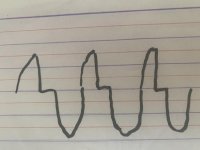hello! i need your inputs, why my solid audio amp has a 65v single rail voltage? it has only 3 big bulk capacitors in parallel. im thinking it will not be loud as other that has dual rail voltages. other 1500 watts amps has dual +-80v to make 1500 watts. thank u
H-bridge amps are like bridged amps. The 65v is like ±65.
It's also likely that the two amps are rated in different ways.
Post photos if you need more speculation.
It's also likely that the two amps are rated in different ways.
Post photos if you need more speculation.
1) your amp probably has a bridged power amp, so your single 65V is equivalent to 2 x 65V split supply.
2) in any case, "all others" use 80V rail(s) for "1500W" , you only have 65V available, that means you have around 60% of "their" power possible
3)n in any case your amp has a 30A fuse.
So with ideal 14.4V supply (with car engine revving up) your maximum **DC input power** is 30*14.4=432W input and with average 12.6V from your battery some 30X12.6=378 W input
Given that´s "fuse blowing" power plus amp is not 100% efficient, ven if Class D, I suspect your amp has no more than 250/300W RMS.
And that for 1 ohm load (their spec, not mine).
But that´s easy to check: connect a scope across speaker out, inject a 250 Hz tone to input https://www.mediacollege.com/audio/tone/files/250Hz_44100Hz_16bit_30sec.mp3 , start rising volume until it clips, slowly lower it until it cleans up and measure voltage, calculate power.
EDIT: your waveform seems to show that the positive half collapses under maximum load.
When/if that happens, disconnect load, or switch to a higher value one (i.e. 2 ohm>4 ohm) , what happens?
I see it more as an "output MosFets can´t handle the current" problem than anything else.
Maybe one blew open (or a related tracks) leaving the one(s) in parallel with a harder job to do, which is only noticed at highish power.
2) in any case, "all others" use 80V rail(s) for "1500W" , you only have 65V available, that means you have around 60% of "their" power possible
3)n in any case your amp has a 30A fuse.
So with ideal 14.4V supply (with car engine revving up) your maximum **DC input power** is 30*14.4=432W input and with average 12.6V from your battery some 30X12.6=378 W input
Given that´s "fuse blowing" power plus amp is not 100% efficient, ven if Class D, I suspect your amp has no more than 250/300W RMS.
And that for 1 ohm load (their spec, not mine).
But that´s easy to check: connect a scope across speaker out, inject a 250 Hz tone to input https://www.mediacollege.com/audio/tone/files/250Hz_44100Hz_16bit_30sec.mp3 , start rising volume until it clips, slowly lower it until it cleans up and measure voltage, calculate power.
EDIT: your waveform seems to show that the positive half collapses under maximum load.
When/if that happens, disconnect load, or switch to a higher value one (i.e. 2 ohm>4 ohm) , what happens?
I see it more as an "output MosFets can´t handle the current" problem than anything else.
Maybe one blew open (or a related tracks) leaving the one(s) in parallel with a harder job to do, which is only noticed at highish power.
Last edited:
- Home
- General Interest
- Car Audio
- solid audio f-15d distorted when loud
